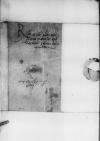List #2504
Bona Sforza do Ioannes DANTISCUSVilnius, 1541-10-28
| odebrano Heilsberg (Lidzbark Warmiński), 1541-11-16 Rękopiśmienne podstawy źródłowe:
| ||||
Tekst + aparat krytyczny + komentarz Zwykły tekst Tekst + komentarz Tekst + aparat krytyczny
Reverendo in Christo Patri, domino
Reverende in Christo Pater written over ri⌈rierer written over ri⌉ sincere nobis dilecte.
Redditae sunt nobis litterae Vestrae Paternitatis, quibus nos salutavit et felicia quaeque nobis est precata. Nos pro eo officio ac studio Vestrae Paternitatis erga nos magnas ei habemus gratias illamque vicissim multa salute impartimur et fausta laetaque omnia ei precamur optantes, ut Vestra Paternitas optatis successibus et diuturna ac incolumi perfruatur valetudine. De rebus autem externis domesticisque, si quid habuerit novi, id ut nobis Vestra Paternitas perscribat, ab illa postulamus.
Dat(ae) or Dat(um)⌈Dat(ae)Dat(ae) or Dat(um)⌉
Ex commissione propria
s(erenissimae) or s(acrae)⌈s(erenissimae)s(erenissimae) or s(acrae)⌉


 Bcz, 1601, p. 686
Bcz, 1601, p. 686